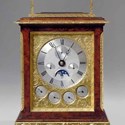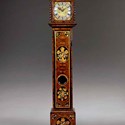A critical mass of half a dozen leading dealers at Masterpiece, all doing their utmost to make a splash on this costly (but potentially cost-effective) stage, made this year's event (June 26-July 3) the rival to any auction catalogue and a powerful magnet to attract the core of the horological collecting community, new collectors in the field and the sort of high-level furnishers that the Masterpiece brand seeks to provide.
Choice, the defining characteristic of 21st century retailing, will see the market evolve - if traditionally clock collectors were loyal to their chosen dealer, then here it is hard not to have your head turned by blue-chip material from other quarters - but there is undoubtedly strength in numbers.
Certainly the strong visual showing translated into strong sales at this year's fair.
And discernible trends were those seen in the market as a whole. Kensington Church Street dealer Nigel Raffety neatly summed up the state of play, describing "some new faces, a lot of interest in bracket clock and precision clocks - but longcases are not quite flavour of the month".
The fashion is towards the small and the portable, with larger pieces a little at odds with the modern interior.
Viner Carriage Clock
Lewes-based dealer Anthony Woodburn enjoyed an excellent fair, selling 15 pieces (something almost every day) including an exceptional month-duration, perpetual calendar carriage clock by Charles Edward Viner of Regent Street for "several hundred thousand pounds".
Viner produced some of the finest English travelling clocks ever to be made and this example c.1830 with a twin-train fusee movement and duplex escapement strikes the quarters on two gongs, the hours on a single gong and the alarm on a bell.
Longcases were, as a general rule, more difficult but exceptions are made for precision technology by great makers or golden age clocks.
Significant sales included an elegant 7ft 5in (2.25m) mahogany longcase clock c.1775 by one of the most celebrated partnerships of the 18th century, Thomas Mudge and William Dutton, and a 6ft 5in (1.96m) walnut and marquetry longcase with an eight-day duration movement by Daniel Quare c.1695. Mr Woodburn also sold one of Quare's famous patent portable barometers - this early example in walnut on four cast brass folding feet c.1695.
A longcase by Mudge and Dutton and a rare bracket clock by Quare were among eight pieces sold at Masterpiece by London specialist John Carlton-Smith.
Two sales were to new clients. The Quare c.1700 boasted a number of sophistications: in addition to a three-train, quarter-striking movement the unusual dial layout included four subsidiaries - for pendulum regulation and locking during travel.
Six of Carlton-Smith's sales were bracket clocks (the other an unsigned miniature 17th century lantern clock with alarm c.1690). In recent years the dealer has observed increased interest in the work of the celebrated Knibb family and here sold a table clock by Joseph Knibb c.1685 appealing for both its small size and a walnut (rather than an ebonised) case.
Carter Wright, the dealership in Stroud, Gloucestershire, also reported a great fair and their sales included their star turn, a rare George Graham regulator of c.1745 with a thermometer in the arch, one of only three known examples.
William and Mary Longcase
With stands at the Olympia International Art and Antiques Fair and then Masterpiece, and a new gallery in the offing, Howard Walwyn - a former director of Raffety & Walwyn but now trading on his own account - was among the busier horology dealers this season. He described Olympia as a worthwhile outing but Masterpiece had proved the better event in terms of sales.
A new client had bought three pieces - including a William and Mary marquetry longcase by Robert Seignior, London - while a major sale via an agent was a miniature musical silver-mounted tortoiseshell bracket clock by William Jourdain. Dating from c.1780, it stood just 13½in (24cm) high and played a choice of four tunes.
Following 12 months' trading at home and from gallery space shared with Silverman on Campden Street, Howard Walwyn Fine Antique Clocks will shortly be under their own roof at 123 Kensington Church Street.
They are staunch believers in the need for gallery space for reasons of proper display and credibility with clients, and a four-month revamp of the shop (formerly the Lucy B. Campbell gallery) should be completed in time for opening in the autumn.








